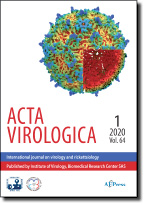Journal info
|
||
Select Journal
Journals
Bratislava Medical Journal Endocrine Regulations General Physiology and Biophysics Neoplasma Acta Virologica Current articles 2023 2022 2021 2020 2019 2018 2017 2016 2015 2014 2013 2012 2011 2010 2009 2008 2007 2006 2005 2004 2003 Studia Psychologica Cardiology Letters Psychológia a patopsych. dieťaťa Kovove Materialy-Metallic Materials Slovenská hudbaWebshop Cart
Your Cart is currently empty.
Info: Your browser does not accept cookies. To put products into your cart and purchase them you need to enable cookies.
Acta Virologica Vol.48, p.91-96, 2004 |
||
| Title: PATHOGENETICAL CHARACTERIZATION OF ISOLATE MHV-60 OF MOUSE HERPESVIRUS STRAIN 68 | ||
| Author: M. PAPPOVÁ, M. STANČEKOVÁ, I. SPISSÁKOVÁ, V. ĎURMANOVÁ, J. MISTRÍKOVÁ | ||
| Abstract: Infection of mice with mouse herpesvirus strain 68 (MHV-68) is an excellent small animal model of gammaherpesvirus pathogenesis in a natural host. We carried out comparative studies on MHV-60, another isolate of MHV-68. The acute infection of BALB/c mice inoculated intranasally (i.n.) with MHV-60 as well as its impact on tumor development were investigated. During the acute phase of infection the lungs were the main tissues infected. Our results show that MHV-60 has similar pathological features like other 4 isolates so far examined, namely MHV-72, MHV-78, MHV-©umava inclusive of MHV-68. Nevertheless, MHV-60 differed from other isolates in following features: (i) the acute phase of infection was established very soon and lasted 10 days post infection (p.i.) in contrast to 14–28 days p.i. in the abovementioned isolates with a peak on days 3–5 p.i. The virus could also be recovered from the spleen, thymus and kidneys but not in other investigated organs. A lymphoproliferative response was associated with splenomegaly. At this time an increase in the number of leukocytes and appearance of atypical leukocytes in peripheral blood were observed. (ii) the infection was localized in the lungs and spleen, while in other isolates it was detected in a much broader scale of organs, and (iii) the acute phase of infection was accompanied by a massive splenomegaly, which was characteristic for the chronic phase of infection. Despite the fact that after clearance of the acute infection the virus was hardly detected, the tumor formation was later observed in 22% of infected mice as compared to 5% in control non-infected mice. |
||
| Keywords: MHV-60; MHV-68; pathogenesis; tumors; lymphoma | ||
| Year: 2004, Volume: 48, Issue: | Page From: 91, Page To: 96 | |
|
|
 download file download file |
|

